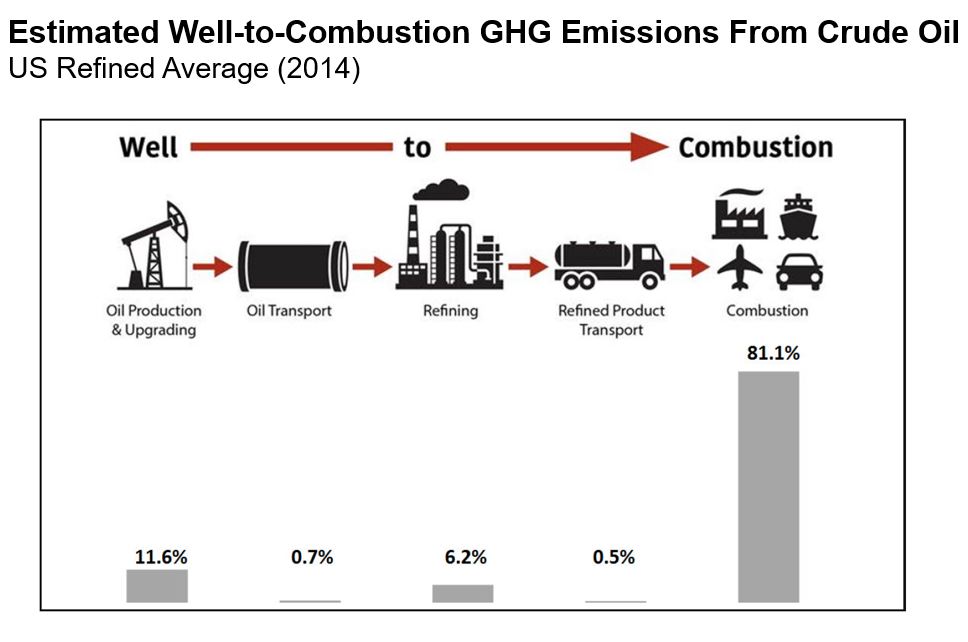TMX Expansion: The Focus Should be on Tailpipes, Not Pipelines
“Build It! Build It!” yelled one group. “No TMX! No TMX!” shouted the other. A police line separated the opposing groups. Sadly, this is the current state of Canada’s pipeline conversation. While there are wide-ranging messages on the protest signs – including concerns about marine traffic and the risk of spills – the proposed pipeline’s effect on climate change is one of the central issues.
The “no” group believes the pipeline is a tipping point for a warmer planet. But the reality is that constraining one source of supply, or even just one pipeline, is futile in solving the climate change challenge. There is no shortage of alternate oil suppliers in the world. Like a whack-a-mole game, the void created from stopping one source of supply gets filled by another country that pops-up to replace the deficit.
Replacing Canadian crude with another source does not perceptibly change global emissions. Figure 1 shows the breakdown of average GHG emissions generated from a barrel of oil – from production and refining through to final consumption. The vast majority of all emissions from crude oil (over 80 percent) come from combusting the fuel in engines—in other words driving your car or flying in an airplane. Whether the crude oil comes from the Canadian oil sands, the United States, Russia, or the Middle East, the tailpipe emissions from an engine are nearly the same.
 Source: ARC Energy Research Institute. “Crude Oil Investing in a Carbon Constrained World” October 2017. Using Data from DOE/NETL for characterizing production and upgrading emissions.
Source: ARC Energy Research Institute. “Crude Oil Investing in a Carbon Constrained World” October 2017. Using Data from DOE/NETL for characterizing production and upgrading emissions.
While it is true oil sands are on the higher end of the GHG emissions spectrum during the upstream production and upgrading phase, when all the emissions are considered (including the tailpipe emissions) the gap is not as wide. Further, forward-looking oil sands producers are already innovating to reduce their carbon intensities, with demonstrable improvements. The two most recent oil sands mining projects, Suncor Energy Inc. operated Fort Hills and Imperial Oil Ltd.’s Kearl both produce diluted bitumen blends with emission profiles that are in the range of an average barrel of crude oil refined in the United States.[1] When ramped up to their full capacity, these two low carbon oil sands megaprojects will supply over 500,000 B/d of diluted bitumen, equal to 15 percent of all oil sands supply.
Alberta’s carbon policy is creating incentives for lower oil sands emissions in the future. Higher carbon facilities are taxed and the total emissions from the sector are capped. No other country has imposed an emissions cap on their oil and gas industry, and few have a carbon tax. Because of this, other oil producing jurisdictions, including the world’s largest producers – Saudi Arabia, Russia and the United States[2] – are not expected to reduce their carbon footprint at all.
On the oil demand side of the equation, the global trend is towards using more oil. A lot more. Since the TMX project was announced six years ago by Kinder Morgan Inc., world oil demand has grown more than 12 times the amount of TMX’s capacity expansion of 590,000 B/d. This year alone, in 2018, world oil consumption is projected to grow by more than two TMX expansions.
Globally, strong economic growth is stimulating more demand for heavy hauling, aviation, shipping and plastics. Despite the emergence of zero-emission electric vehicles, demand from light duty vehicles is also accelerating. Over the past several years, cheap oil has stimulated increasing sales of fuel hungry SUVs and trucks. This is not just a North American trend. JATO Dynamics (an automotive research provider) predicts that in 2018 more than half of all global car sales will be oil thirsty sports utility vehicles, compared to 40 percent in 2015.[3]
While the Canadian Federal government’s purchase of Trans Mountain increases the chances the project will be built, the anti-pipeline demonstrations will continue and intensify. The troublesome fact is, even if the protestors could stop the pipeline, they will not succeed in solving the pressing issue at hand: climate change. The only way to meaningfully reduce world greenhouse gas (GHG) emissions is by restraining the amount of fossil fuels – including oil – that are consumed. Protesting for rules to make combustion engines use less petroleum or initiatives to increase the fleet of electric vehicles fueled by low carbon electrons would be a better use of time.
[1] Source: Suncor May, 2018 Investor Presentation, “[Fort Hills GHG emissions are] in line with the average crude oil refined in the United States” page 23 http://www.suncor.com/investor-centre# . Imperial website “Kearl is able to produce blended bitumen with about the same life-cycle greenhouse gas emissions as many other crude oils refined in the United States” http://www.imperialoil.ca/en-ca/company/operations/oil-sands/kearl
[2] The United States Federal Government does not impose a carbon levy on upstream oil and gas production. California has a cap and trade policy, however oil and gas producers are given free allocations at least until 2020 under the current system. While some states have methane reduction policies such as Colorado, the US lacks a strong Federal mandate like Canada’s.
[3] Simon Wright, “SUV for Victory,” The Economist, November 2017.


